By The History Man
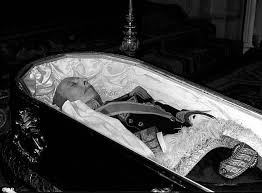 Tomorrow, November 20, is the 49th anniversary of the death of Spanish dictator General Franco. The History Man remembers the day Franco died in 1975 and writes a short history of the man who outlived by three decades his fascist contemporaries, Adolf Hitler and Benito Mussolini.
Tomorrow, November 20, is the 49th anniversary of the death of Spanish dictator General Franco. The History Man remembers the day Franco died in 1975 and writes a short history of the man who outlived by three decades his fascist contemporaries, Adolf Hitler and Benito Mussolini.
General Franco is laid to rest [Photo: Daily Mail]
How I found out
In November 1975 I was a young teacher in Cheshire in the North West of England. I was in my second year of teaching Spanish. One Thursday Vicente, our somewhat dour Spanish assistant, rushed into the staff room, all smiles and talking excitedly in his native tongue. “El sinverguenza ha fallecido por fin" ("The bastard’s dead at last!”) he cried in Spanish. “Who’s dead?” I asked.
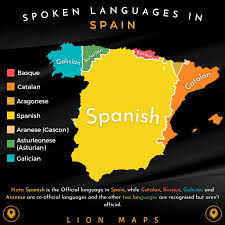 Generalísimo Franco, Spain’s dictator for almost 40 years, had finally passed away after a lengthy illness. Vicent, as he became at a stroke, was thrilled to bits. Apart from all the atrocities that could be laid at Franco’s door, he had for forty years repressed the linguistic minorities in Spain. The Basques, the Catalans and the Galicians were forbidden to use their native languages euskera, catalán and gallego. So, also the Valencians. Vicent was a valenciano, so from that November day on he decided he would be known by his nombre valenciano, Vicent.
Generalísimo Franco, Spain’s dictator for almost 40 years, had finally passed away after a lengthy illness. Vicent, as he became at a stroke, was thrilled to bits. Apart from all the atrocities that could be laid at Franco’s door, he had for forty years repressed the linguistic minorities in Spain. The Basques, the Catalans and the Galicians were forbidden to use their native languages euskera, catalán and gallego. So, also the Valencians. Vicent was a valenciano, so from that November day on he decided he would be known by his nombre valenciano, Vicent.
This policy of linguistic repression was somewhat odd, given that Francisco Franco Bahamonde was a gallego, born in El Ferrol in Galicia in 1892 into an upper-class military family.
Languages of Spain [Image courtesy of Reddit]
Franco's early career
Franco enrolled in the Spanish Army as a cadet and rose quickly through the ranks to become brigadier general aged 33, the youngest general in Spain.
After leading the suppression of the 1934 uprising in Asturias, Franco was briefly elevated to Chief of Army Staff before the 1936 election moved the leftist Popular Front into power, relegating him to the Canary Islands. After initial reluctance, he joined the July 1936 military coup which sparked the Spanish Civil War.
During the civil war, he commandeered Spain’s colonial army in Africa and, after the deaths of many of the rebel leadership, became his faction’s only leader, later appointed Generalísimo and Head of State in 1936.
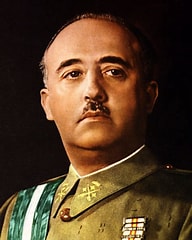 Three years later the Guerra Civil ended when the nationalists declared victory which extended Franco’s dictatorship over Spain through a period of repression of political opponents. His dictatorship’s use of forced labour, concentration camps, and executions led to between 30,000 and 50,000 deaths after the war. Combined with wartime killings, this brings the death toll of the so-called “White Terror” to between 100,000 and 200,000.
Three years later the Guerra Civil ended when the nationalists declared victory which extended Franco’s dictatorship over Spain through a period of repression of political opponents. His dictatorship’s use of forced labour, concentration camps, and executions led to between 30,000 and 50,000 deaths after the war. Combined with wartime killings, this brings the death toll of the so-called “White Terror” to between 100,000 and 200,000.
In post-Civil-War Spain, Franco ruled with more power than any Spanish leader before or since, and developed a cult of personality around his rule by founding the Movimiento Nacional. During World War II he maintained Spanish neutrality but supported the Axis, whose members Italy and Germany had supported him during the Civil War, in various ways, thereby damaging the country’s international reputation.
[Photo courtesy of Wikipedia]
Franco as Spanish dictator
During the start of the Cold War, Franco lifted Spain out of its mid-20th century economic depression through technocratic and economically liberal policies, presiding over a period of rampant growth known as the “Spanish miracle”.
Franco started struggling with Parkinson’s disease in the 1960s. Owing to advanced age and illness, in 1973 he resigned as prime minister, separated from the head of state office since 1967, but remained in power as the head of state and commander-in-chief of the military.
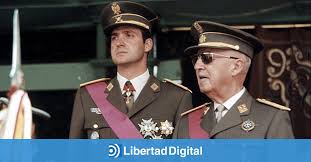 Always a monarchist, Franco had restored the monarchy in his final years, by nominating Juan Carlos de Borbón as his successor to the role of head of state.
Always a monarchist, Franco had restored the monarchy in his final years, by nominating Juan Carlos de Borbón as his successor to the role of head of state.
Two days after his death, Juan Carlos became King of Spain, and led the Spanish transition to democracy.
Juan Carlos with Franco [Libertad Digital]
Spain post-Franco
The legacy of Franco in Spanish history remains controversial as the nature of his dictatorship changed over time. His reign was marked by both brutal repression, with thousands killed, and economic prosperity, which greatly improved the quality of life in Spain.
His dictatorial style proved highly adaptable, which enabled wide-sweeping social and economic reform, while consistent pursuits during his reign centred on highly centralised government, authoritarianism, nationalism, national Catholicism, anti-freemasonry, and anti-communism.
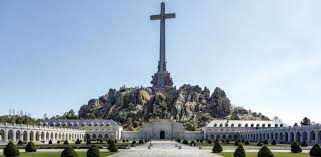 Franco was controversially buried in the Valle de los Caídos (Valley of the Fallen), the huge mausoleum outside Madrid he had built by the forced labour of political prisoners to honour the dead of both sides in the Civil War. He was the only person interred there who did not die during the conflict.
Franco was controversially buried in the Valle de los Caídos (Valley of the Fallen), the huge mausoleum outside Madrid he had built by the forced labour of political prisoners to honour the dead of both sides in the Civil War. He was the only person interred there who did not die during the conflict.
After much campaigning, in October 2019 Franco’s remains were removed from the Valley and reburied alongside his wife, Carmen, in a cemetery near Madrid.
Valle de los Caídos [Photo: La Vanguardia]
Endpiece
Back in that staff room in Cheshire in 1975, I don’t think Vicent or I or anyone else thought that Spain’s transition to democracy and a constitutional monarchy would be so rapid and successful.
"The bastard’s dead, long live the King!"
© The History Man
With thanks to:
Daily Mail
La Vanguardia
Libertad Digital
Paul Whitelock
Wikipedia
Recommended reading:
Between Two Fires by David Baird (Maroma Press, 2008)
Guerra by Jason Webster (Black Swan, 2006)
The Spanish Civil War – A Very Short Introduction by Helen Graham (Oxford UP, 2005)
The Rise and Fall of King Juan Carlos I
Tags:
Adolf Hitler, Benito Mussolini, Between Two Fires, communism, David Baird, death, democracy, dictator, General Franco, Guerra, Helen Graham, Jason Webster, Juan Carlos, king, Paul Whitelock, Spain, Spanish Civil War, Valle de los Caídos, Valley of the Fallen, Wikipedia, World War II